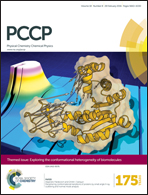Transnitrosylation products of the dipeptide cysteinyl–cysteine: an examination by tandem mass spectrometry and density functional theory†
Abstract
The fragmentation pathways of protonated mono- and di-nitrosylated derivatives from the dipeptide Cys–Cys obtained by electrospray were examined. Protonated mononitrosylated dipeptide upon loss of ˙NO formed a radical cation, which in turn shows two fragment ions, one from the loss of HS˙ and the other from a neutral loss giving a radical cation of formula C2H5NS˙+. Protonated dinitrosylated dipeptide dissociated by losing both ˙NO molecules, forming a cyclic structure with a vicinal disulfide bridge whose major dissociation channel was the loss of CO. After CO loss, two pathways were observed (loss of NH3 and C2H3NS) which were preceded by proton exchange occurring between one β-carbon and the nitrogen atom. DFT calculations did not show significant differences in the energies involved for the loss of the NO radical from either of the cysteine residues of the protonated di-nitrosylated dipeptide. Upon loss of the first NO radical, the thiyl radical afforded the vicinal disulfide product with a small barrier through radical substitution of the remaining NO moiety. The calculated relative energy barriers for the different channels are in good agreement with experimental observations. Structures of the ions obtained after dissociation are suggested on the basis of the proposed mechanisms.


 Please wait while we load your content...
Please wait while we load your content...